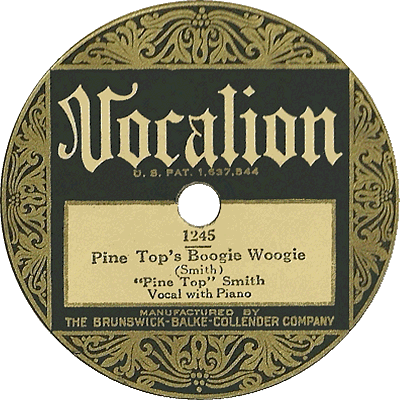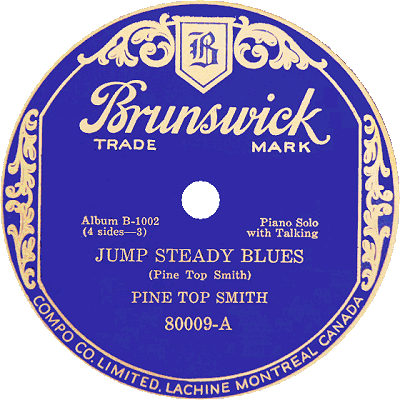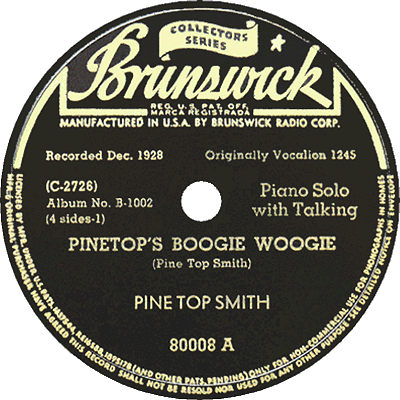Clarence Smith came from deep in the heart of Alabama. He was born in Troy, Alabama to Sam Smith, a mulatto born in North Carolina, and his much younger wife Molly (or Mollie) Smith, a black native of Alabama. Clarence was the last of nine children including his four sisters and four brothers, Jay C. (5/1883), Emma (8/1885), Samuel Jr. (8/1889), Clem (12/1892), Oby (3/1895), Bertha (8/1895), Gussie (1/1900) and Annie (1903). For the 1900 enumeration Sam was shown as a day laborer in Troy. In the 1910 census he was listed as a gardener and three of his oldest children remaining in the household working at either farm or manual labor. Clarence earned his "Pine Top" nickname early on for his propensity to climb high up in trees. At some point in the 1910s, some of the family moved north to Birmingham. Having been playing piano for a few years and developing his own style derived from the blues he had heard all around him, Clarence first performed publicly in Birmingham at around age fifteen. According to older brother Clem's 1917 draft record, their father may have died by this time as Clem shows himself supporting his mother. Molly is shown as widowed and back in Troy in 1920. However, Clarence relocated north, this time to Pittsburgh, Pennsylvania, where he launched his career as a performer.
Based for a time in the Steel City, Smith joined the Theatre Owners Booking Association (TOBA) Vaudeville circuit working in multiple guises as a pianist, singer, and sometimes comedian actor in ethnic roles, typical for that time. He was one of Maddy Dorsey's pickaninies in the beginning.  The youth was able to refine his style while listening to or working with some of the better blues pianists and singers of the early 1920s, including Gertrude "Ma" Rainey, and the comic husband and wife singing duo, Butterbeans and Susie. Clarence was focusing more on piano as his stint with TOBA progressed, often taking in the local night spots on their tours where barrelhouse pianists played the deepest of blues. Among the most common stops was Dallas, Texas, where many of the patterns derived from steam locomotive rhythms had found their way into Texan pianists' styles. Smith also was able to perform at rent parties, local taverns, and the occasional brothel. He also potentially heard brothers George Washington Thomas and Hersal Thomas play their early bass-driven blues works, such as The Fives and The Rocks, further informing his style.
The youth was able to refine his style while listening to or working with some of the better blues pianists and singers of the early 1920s, including Gertrude "Ma" Rainey, and the comic husband and wife singing duo, Butterbeans and Susie. Clarence was focusing more on piano as his stint with TOBA progressed, often taking in the local night spots on their tours where barrelhouse pianists played the deepest of blues. Among the most common stops was Dallas, Texas, where many of the patterns derived from steam locomotive rhythms had found their way into Texan pianists' styles. Smith also was able to perform at rent parties, local taverns, and the occasional brothel. He also potentially heard brothers George Washington Thomas and Hersal Thomas play their early bass-driven blues works, such as The Fives and The Rocks, further informing his style.
 The youth was able to refine his style while listening to or working with some of the better blues pianists and singers of the early 1920s, including Gertrude "Ma" Rainey, and the comic husband and wife singing duo, Butterbeans and Susie. Clarence was focusing more on piano as his stint with TOBA progressed, often taking in the local night spots on their tours where barrelhouse pianists played the deepest of blues. Among the most common stops was Dallas, Texas, where many of the patterns derived from steam locomotive rhythms had found their way into Texan pianists' styles. Smith also was able to perform at rent parties, local taverns, and the occasional brothel. He also potentially heard brothers George Washington Thomas and Hersal Thomas play their early bass-driven blues works, such as The Fives and The Rocks, further informing his style.
The youth was able to refine his style while listening to or working with some of the better blues pianists and singers of the early 1920s, including Gertrude "Ma" Rainey, and the comic husband and wife singing duo, Butterbeans and Susie. Clarence was focusing more on piano as his stint with TOBA progressed, often taking in the local night spots on their tours where barrelhouse pianists played the deepest of blues. Among the most common stops was Dallas, Texas, where many of the patterns derived from steam locomotive rhythms had found their way into Texan pianists' styles. Smith also was able to perform at rent parties, local taverns, and the occasional brothel. He also potentially heard brothers George Washington Thomas and Hersal Thomas play their early bass-driven blues works, such as The Fives and The Rocks, further informing his style.Along the way Smith got married to Sarah Horton in the mid-1920s and soon had a son. By this time he had a fairly well developed boogie style, and enhanced it with a moving bass ("eight to the bar"), something that he (or perhaps one of his contemporaries) coined as Boogie Woogie. His signature piece was, of course, Pine Top's Boogie Woogie, which by his own account had originated at a house party in St. Louis, Missouri. The boogie and boogie woogie styles actually originated in the barrelhouses of the deep south, particularly New Orleans, but moved north with itinerant pianists in the early to mid-1920s. It was a hard driving derivation of the familiar twelve bar blues pattern, but more joyful, and with a variety of left hand patterns. Smith soon became a master of boogie woogie and his reputation spread. As for claims that he invented the name of the style, the answer may never be known for sure, as Charles "Cow Cow" Davenport, also from Alabama, had a similar claim. At more than a decade older than Smith, Davenport may have also been an influence, given that he had traveled on some of the same circuits as Smith. Cow Cow was also able to pinpoint the term "boogie" in relation to the bogeyman or devil, calling it music that was performed in places where nice people didn't go. In any case, the label was becoming somewhat more common by the late 1920s. Davenport later claimed that he not only relayed the genre name to Smith, but helped to get him into the right place at the right time:
The boogie and boogie woogie styles actually originated in the barrelhouses of the deep south, particularly New Orleans, but moved north with itinerant pianists in the early to mid-1920s. It was a hard driving derivation of the familiar twelve bar blues pattern, but more joyful, and with a variety of left hand patterns. Smith soon became a master of boogie woogie and his reputation spread. As for claims that he invented the name of the style, the answer may never be known for sure, as Charles "Cow Cow" Davenport, also from Alabama, had a similar claim. At more than a decade older than Smith, Davenport may have also been an influence, given that he had traveled on some of the same circuits as Smith. Cow Cow was also able to pinpoint the term "boogie" in relation to the bogeyman or devil, calling it music that was performed in places where nice people didn't go. In any case, the label was becoming somewhat more common by the late 1920s. Davenport later claimed that he not only relayed the genre name to Smith, but helped to get him into the right place at the right time:
 The boogie and boogie woogie styles actually originated in the barrelhouses of the deep south, particularly New Orleans, but moved north with itinerant pianists in the early to mid-1920s. It was a hard driving derivation of the familiar twelve bar blues pattern, but more joyful, and with a variety of left hand patterns. Smith soon became a master of boogie woogie and his reputation spread. As for claims that he invented the name of the style, the answer may never be known for sure, as Charles "Cow Cow" Davenport, also from Alabama, had a similar claim. At more than a decade older than Smith, Davenport may have also been an influence, given that he had traveled on some of the same circuits as Smith. Cow Cow was also able to pinpoint the term "boogie" in relation to the bogeyman or devil, calling it music that was performed in places where nice people didn't go. In any case, the label was becoming somewhat more common by the late 1920s. Davenport later claimed that he not only relayed the genre name to Smith, but helped to get him into the right place at the right time:
The boogie and boogie woogie styles actually originated in the barrelhouses of the deep south, particularly New Orleans, but moved north with itinerant pianists in the early to mid-1920s. It was a hard driving derivation of the familiar twelve bar blues pattern, but more joyful, and with a variety of left hand patterns. Smith soon became a master of boogie woogie and his reputation spread. As for claims that he invented the name of the style, the answer may never be known for sure, as Charles "Cow Cow" Davenport, also from Alabama, had a similar claim. At more than a decade older than Smith, Davenport may have also been an influence, given that he had traveled on some of the same circuits as Smith. Cow Cow was also able to pinpoint the term "boogie" in relation to the bogeyman or devil, calling it music that was performed in places where nice people didn't go. In any case, the label was becoming somewhat more common by the late 1920s. Davenport later claimed that he not only relayed the genre name to Smith, but helped to get him into the right place at the right time:I happened to hit Pittsburgh at the Star Theater on [Wylie] Avenue. Being a piano player I would go around to all the honky-tonks in town. I went with a friend of mine to the Sachem Alley, and there I met Pine Top Smith. He had heard my "Cow Cow Blues," wanted to meet me. He sat down playin'. Didn' know what he was playin', so I said, 'Boy, look here, you sure have got a mean boogie woogie.' Pine Top didn't know what he was playin' nohow. I began to tell him what it was, then he tried to sing it. He never could rhyme it together, just said 'Come up here gal, to this piano… playin' my boogie woogie'.
In essence, Davenport claims to have given Pine Top the name of his most identifiable piece that also helped to define the genre, which may be a bit of a stretch, but the story is included here for context. Note that according to historian and performer Bob Pinsker, Wylie Avenue (misspelled as Wile in the article) was in the center of the black community of Pittsburgh during that era. According to Cow Cow, he encouraged Smith to move his family to Chicago in late 1927 or early 1928. For a time they roomed in the same home as two other pianists who were playing the same style, and which cited him as an influence as well; Meade "Lux" Lewis and Albert Ammons. Lewis had already recorded his signature Honky Tonk Train Blues but it had not been released. Since Albert was the one with the piano, the trio often hung out at in his room. A second child was soon added to the Smith family. By this time, Davenport had the benefit of being connected to the recording industry, working as a staff composer and talent scout for Vocalion Records, the Brunswick Records race record subsidiary. He hooked Clarence up with black producer Mayo Williams of Vocalion, a former college football player who had been working previously with Paramount Records in Chicago, and had launched a couple of his own labels which had failed. Once Williams was working for Vocalion Records, he took "Pine Top" on to make some records. Smith cut his first sides at the end of 1928. While performing Pine Top's Boogie Woogie the composer talked over the playing giving instructions on how to dance to the tune. When released, it was allegedly the first record with the name "boogie woogie" on the label, and it soon became a hit in Chicago and beyond.
He hooked Clarence up with black producer Mayo Williams of Vocalion, a former college football player who had been working previously with Paramount Records in Chicago, and had launched a couple of his own labels which had failed. Once Williams was working for Vocalion Records, he took "Pine Top" on to make some records. Smith cut his first sides at the end of 1928. While performing Pine Top's Boogie Woogie the composer talked over the playing giving instructions on how to dance to the tune. When released, it was allegedly the first record with the name "boogie woogie" on the label, and it soon became a hit in Chicago and beyond.
 He hooked Clarence up with black producer Mayo Williams of Vocalion, a former college football player who had been working previously with Paramount Records in Chicago, and had launched a couple of his own labels which had failed. Once Williams was working for Vocalion Records, he took "Pine Top" on to make some records. Smith cut his first sides at the end of 1928. While performing Pine Top's Boogie Woogie the composer talked over the playing giving instructions on how to dance to the tune. When released, it was allegedly the first record with the name "boogie woogie" on the label, and it soon became a hit in Chicago and beyond.
He hooked Clarence up with black producer Mayo Williams of Vocalion, a former college football player who had been working previously with Paramount Records in Chicago, and had launched a couple of his own labels which had failed. Once Williams was working for Vocalion Records, he took "Pine Top" on to make some records. Smith cut his first sides at the end of 1928. While performing Pine Top's Boogie Woogie the composer talked over the playing giving instructions on how to dance to the tune. When released, it was allegedly the first record with the name "boogie woogie" on the label, and it soon became a hit in Chicago and beyond.Williams was encouraged by the results of the first sessions, and brought him in for two more in mid-January of 1929, where he recorded some of the pieces he had performed while on the Vaudeville circuit. He was soon playing in Chicago hot-spots and had a promising future. One more record was cut on March 13, 1929 [unissued] and another session was to follow on March 16 at Vocalion. On March 15th "Pine Top" Smith was performing at a Chicago dance hall when a fight broke out and gunplay followed. Smith was accidentally [disputed] hit by a bullet from the gun of David Bell. The headline in Downbeat magazine read "I Saw Pinetop Spit Blood and Fall." The world was deprived of a promising string of original performances and compositions by this stellar player who left behind his wife, two children, a handful of records, and a cadre of mourners. Within a few years, some of his cuts were re-released on the main Brunswick label, further increasing his validity as a performer. Smith's posthumous fame continued to grow, and in 1938 bandleader Tommy Dorsey made a hit with his big band version of Pine Top's Boogie Woogie, which has since been in the repertoire of pianists ranging from Vladizu Liberace to Neville Dickie, Bob Milne and Butch Thompson.
This biography was pieced together from many disparate sources, including scant newspaper articles about Smith's death and brief lifetime, public records, recording logs and lists, and some additional information from the informative The Story of Boogie Woogie by Peter J. Silvester.

 Compositions/Discography
Compositions/Discography